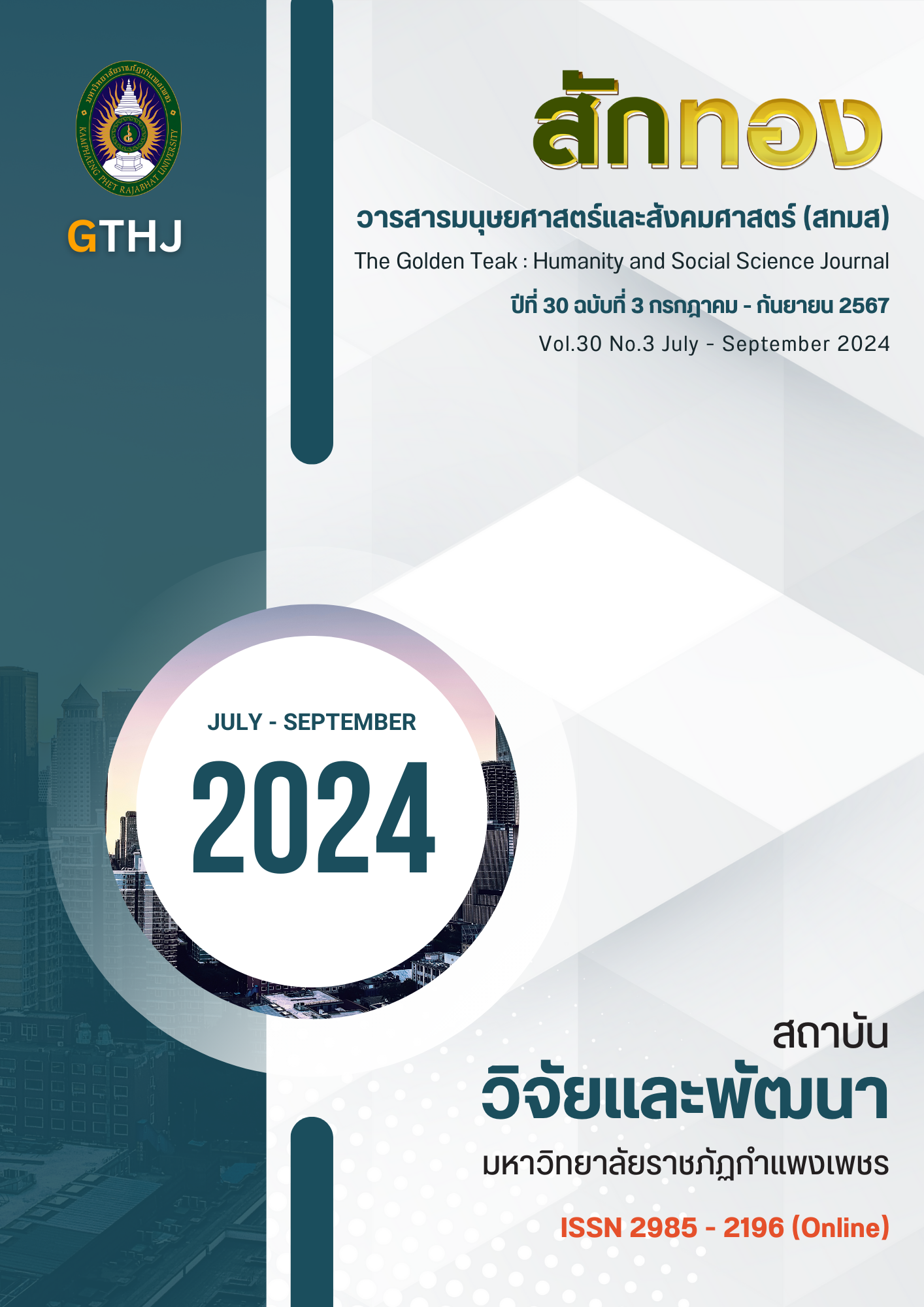Challenges of Thai Learners in Pronouncing English Consonant Sounds
Main Article Content
Abstract
The objective of this paper is to explicate the similarities and differences between Thai and English consonants and to compile the challenges faced by Thai learners in pronouncing consonants in various word positions and clusters. It also elucidates the difficulties encountered by Thai learners in mastering English consonant sounds. It identifies specific difficulties with initial fricatives (excluding /f/, /s/, /h/) and affricates. Difficulties in producing consonant clusters include replacing one consonant sound with another, omitting consonants, and inserting extra consonants. The problematic final consonant sounds are fricatives, affricates, and laterals due to the differences between the phonological systems of English and Thai. To enhance the pronunciation skills of Thai learners and address the challenges in pronouncing English consonants, emphasis should be placed on explicitly teaching these problematic sounds. Additionally, the factors contributing to these difficulties and potential strategies for addressing them are discussed. This paper also provides insights into effective approaches for improving the pronunciation skills of Thai learners to accurately articulate English consonants.
Article Details

This work is licensed under a Creative Commons Attribution-NonCommercial-NoDerivatives 4.0 International License.
บทความที่ได้รับการตีพิมพ์เป็นลิขสิทธิ์ของวารสาร สักทอง : วารสารมนุษยศาสตร์และสังคมศาสตร์ สถาบันวิจัยและพัฒนา มหาวิทยาลับราชภัฏกำแพงเพชร
ข้อคิดเห็นใดๆ ที่ปรากฎในวารสารเป็นวรรณกรรมของผู้เขียนโดยเฉพาะ ซึ่งมหาวิทยาลัยราชภัฏกำแพงเพชรและบรรณาธิการไม่จำเป็นต้องเห็นด้วย
References
Burns. A. & Claire, S. (2003). Clearly speaking pronunciation in action for teachers. Sydney: Macquarie University.
Clement, G. (1992). The sonority cycle and syllable organization. In W Dressler, H Luschützky, O, Pfeiffer, & J. Rennison (Eds.), Phonologica 1988(pp. 63-76). Cambridge University Press.
Endu, P. (2017). A comparative study of Thai and English consonants’ phonemes. Wiwitwannasan[Online Serial], 1, (1). Available: https://so06.tci-thaijo.org/index.php/wiwitwannasan/article/view/192667/137003 [2024, February 25]. [In Thai]
Harmer, J. (2001). The practice of English language teaching. New York : Longman.
Iadkert, K. & Chantarangkul, V. (2023). The relative degree of sonority and English consonant
clusters produced by Thai speakers. Journal of Language and Linguistics [Online Serial], 41, (2). Available: https://so04.tci-thaijo.org/index.php/joling/ article/view/257445/181435 [2024, February 10]. [In Thai]
Jenkins, J. (2000). The phonology of English as an international language. Oxford: Oxford University Press.
Kanokpermpoon, M. (2007). Thai and English consonantal sounds: A problem or a potential
for EFL Learning?. ABAC Journal [Online Serial], 27, (1). Available: http://www.assumptionjournal.au.edu/index.php/ abacjournal/article/view/583/520. [2024, March 10].
Le, H.T. & Boonmoh, A. (2020). Thai Students' production of English coda clusters: An experiment on sonority with Thai university students taking an English fundamental course. Human Behaviour, Development and Society [Online Serial], 21, (2). Available: https://so01.tci-thaijo.org/index.php/hbds/article/view/185265/164137
, March 15].
Makamthong, N. & Hesmatantya, V. (2022). Investigating the English pronunciation deviation among Thai students. ELLTER Journal [Online Serial], 3, (2). Available: https://journal.uhamka.ac.id/index.php/ellter-j/article/view/8972 [2024, March 22].
Mohammed, M. & Idris, S. (2020). Challenges of pronunciation to EFL learners in spoken English. Multicultural Education, 6(5), 193-203.
Morley, J. (1991). The pronunciation component in teaching English to speakers of other languages. TESOL Quarterly [Online Serial], 25, (3). Available: https://www.jstor.org/stable/3586981?origin=crossref [2024, March 23].
Nakin, P. & Inpin, B. (2017). English consonant pronunciation problems of EFL students: A survey of EFL students at Mae Fah Luang University. In Proceedings of the 6th Burapha University International Conference 2017, 3-4 August 2017(pp.185-190). Bangkok : Burapha University. [In Thai]
Naruemon, D. (2013). Thai pre-service teachers' beliefs about the learner-centred approach and their classroom practices. Doctoral Dissertation, Newcastle University.
Noss, R. (1964). Thai : Reference grammar. Washington D.C.: Foreign Service Institute.
Panichkul, S. (2018). A study of the pronunciation of English consonant clusters by Thai speakers in the airline business. In S. Saengboon, R. Rojjanaprapayon, & H. Goto (Chairs), In The 8th international conference on language and communication: Reclaiming language, communication and culture for sustainable society(pp.139-153). The National Institute of Development Administration (NIDA). [In Thai].
Patibat, N. & Cochran, C. (1997). An investigation of sonority dispersion in Thai-English interlanguage codas. In S. Buchner (Ed.), Working papers in linguistics (pp.5-22). George Mason University.
Peerachachayanee, S. (2022). Towards the phonology of Thai English. Academic Journal of Humanities and Social Sciences Burapha University, 30(3), 64-92.
Pourhosein, A. (2012). The significance of pronunciation in English language teaching. English Language Teaching. [Online Serial], 5, (4). Available: https://www.ccsenet.org/journal/index.php/elt/article/view/15940 [2024, February 1].
Roach, P. (2009). English phonetics and phonology: A practical course. (4 th ed.). Cambridge : Cambridge University Press.
Sangka, P. (2021). The problem statement and solution of Thai youths’ pronunciations of ‘/rɔ/’, ‘/lɔ/’, and diphthongs. Journal of SaengKhomKham Buddhist Studies [Online Serial], 6, (1). Available: https://so02.tci-thaijo.org/index.php/jsbs/article/view/ 244099/167583 [2020, April 6]. [In Thai]
Seidlhofer, B. (2001). Pronunciation. In D. Nunan & R. Carter (Eds.), The Cambridge Guide to Teaching English to Speakers of other Languages. New York: Cambridge University Press.
Wei, Y. & Zhou, Y. (2002). Insights into English pronunciation problems of Thai U.S. Educational Resources Information Center (ERIC). [Online]. Available: https://files.eric.ed.gov/fulltext/ED476746.pdf [2024, April 15].


